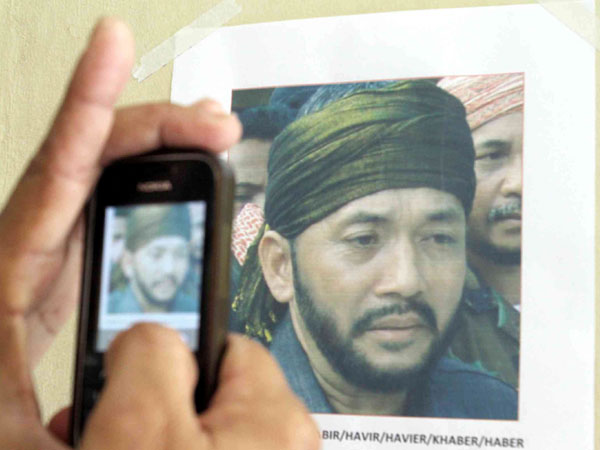
WANTED A wall poster of Habier Abdul Malik is at the main entrance of the central police station in Zamboanga City. EDWIN BACASMAS
COTABATO CITY—Habier Abdul Malik is no stranger to conflict with the government even after the 1996 peace treaty was signed with his group, the Moro National Liberation Front (MNLF).
A Tausug who was born and raised in Panamao town in Sulu, Malik has led skirmishes with government troops and has been in the limelight since February 2007, especially after his group took hostage government officials, including a former military commander.
Panamao is where he would later establish the MNLF’s Camp Bitanag after a long stay overseas to study college at Jamiatul Malik Saud (King Saud University) in Saudi Arabia in the mid 1970s.
Sources said that the last name he had adopted is part of his nom de guerre and came from the name of that school. They were not even sure what his real name was but one thing is certain: He is a respected Muslim cleric and scholar.
Malik is a product of the Philippine public school system and took his secondary education in Panamao, according to Dr. Amildasa Annil, head of the Ulangig Mindanao Security Communication Advocacy in Sulu.
3 children
Malik later married and had three children, one named Hamid, who is also affected by the armed conflict in the heart of Zamboanga City, being a student of an international school there. An older son was killed on the second day of the standoff, their relatives said.
When MNLF founding chair Nur Misuari became the governor of the Autonomous Region in Muslim Mindanao (ARMM) in 2001, he appointed Malik head of the Regional Reunification and Unification Commission, through which he had convinced dozens of MNLF fighters to support the 1996 peace agreement.
Malik made the integration of sons of MNLF combatants, aged 20 years and above, into the military or police as part of his bargaining point.
In February 2005, Malik first drew public attention when he aired on national radio the MNLF’s sentiments against the government for not fulfilling the provisions of the 1996 peace treaty. That was when his followers started engaging government security forces in Panamao.
In late January 2007, the military launched attacks on Abu Sayyaf lairs in Panamao and Malik’s group was dragged into the violence when his camp was reportedly attacked by soldiers.
Hostages?
In subsequent days, peace negotiations with Malik’s group were sought by the government through then Presidential Adviser on the Peace Process Jesus Dureza. In the middle of the talks, the rebels took hostage Dureza, then Marine Gen. Ben Dolorfino, Defense Undersecretary Ramon Santos and the rest of the government’s 20-man team.
During interviews, Dureza apparently evaded the term “hostage,” saying they were only “prevented from leaving when it was time to say goodbye.” They were also subjected to “limited movements” while inside the camp, he said.
Subsequent military offensives forced Malik to abandon Bitanag and fears gripped shoreline communities in Panamao over talks that the MNLF commander was to launch attacks on military encampments in the areas to retake his territory, which was a Special Zone for Peace and Development under the guidelines of the 1996 agreement.
When things quieted down in his territory, Malik continued to work for Misuari as an emissary. But Malik was outside Bitanag by then, as soldiers were occupying his erstwhile camp.
Bitanag
In March 2012, the military beefed up its forces in Bitanag following reports that the MNLF leader was preparing to retake his base.
“Col. (Jose Johriel) Cenabre, the commander of the Joint Sulu Task Force, confirmed that the AFP’s (Armed Forces of the Philippines) Marines Corps were to beef up military forces in Sulu because of information that top MNLF commander Habier Malik [was to] retake Bitanag, his former camp and property, by force,” Annil said.
He said that through the
ARMM’s Bureau of Public Information, Malik denied the information and said his group’s movement was in connection with a major MNLF celebration.
In February this year, Malik told reporters his forces had overrun two camps of the Abu Sayyaf to rescue Jordanian journalist Baker Abdulla Atyani.
He claimed that his men took over Kuta Masarin camp from Abu Sayyaf leader Habib Hajan Sawajaan and that the second camp fell after four days of siege. But he said his group failed to recover the Jordanian.
“We have occupied their stronghold,” Malik said. “But we were not able to find Atyani or anyone from the group holding him hostage,” reporters quoted him as saying.
On Sept. 8, MNLF forces moved into Zamboanga City for a “peace assembly” and the following day, Malik’s forces were fighting government men anew.
As of Saturday, the fighting has continued, which has prompted Annil to comment that there must have been miscommunication between the government and the MNLF.